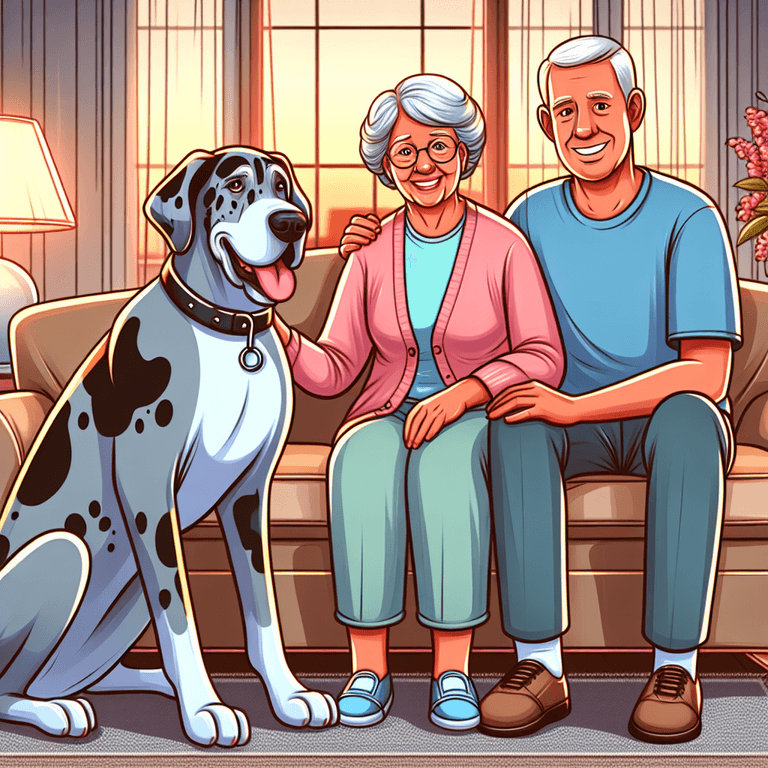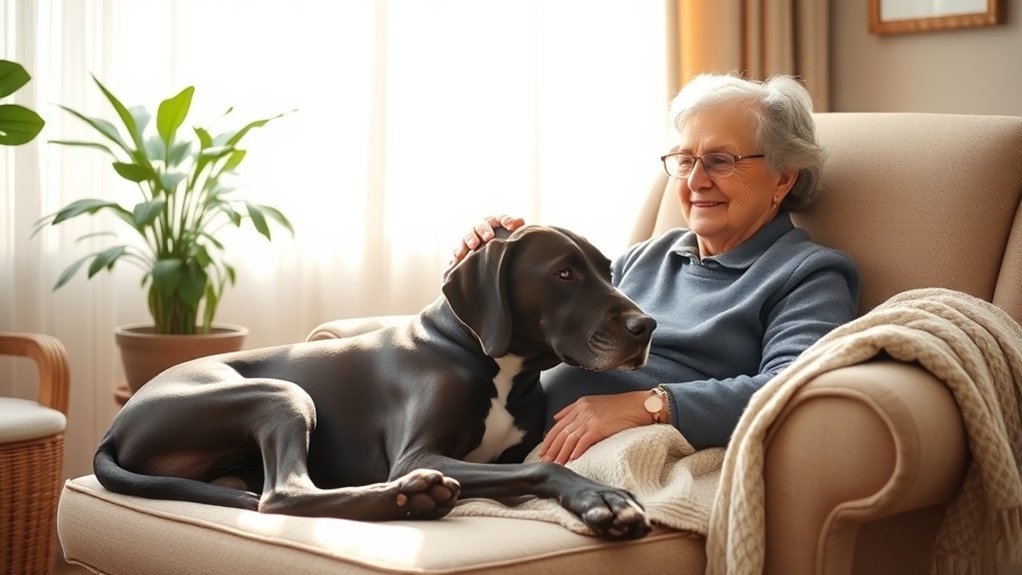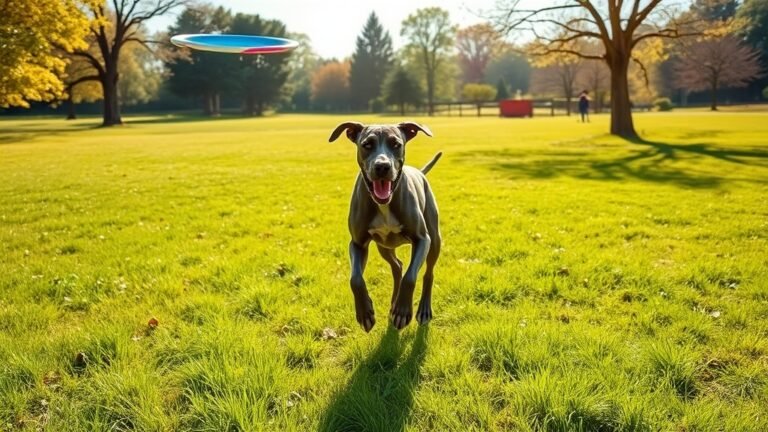I Lean On My Senior, And They Lean On Me

Are Great Danes Good Pets for Seniors
Hey there, humans! It’s me, your friendly neighborhood Great Dane, and I’ve got some tail-wagging news to share about why us gentle giants make awesome pets for seniors.
First off, let me tell you – we’re basically living teddy bears who happen to be the size of small horses. Sure, I might accidentally knock over your coffee table with my enthusiastic tail wagging, but that means we’re excited to see you! My calm and gentle personality means I won’t be bouncing off the walls like those crazy little terriers. I prefer a nice afternoon nap on the couch (okay, fine, I’ll take up the WHOLE couch).
Now, about exercise – don’t worry, I’m not going to drag you on a marathon. A nice leisurely walk around the block is perfect for both of us. I like to think of myself as the ideal walking buddy who won’t judge you for stopping to catch your breath. Plus, I’m greatly motivated to get outside every day, even if it’s just so I can sniff that interesting fire hydrant on the corner.
I’ll be honest, though – I do need a pretty big house. I’m not exactly apartment-sized unless you want me sleeping on top of your dining room table. But hey, think of me as a four-legged home security system! Nobody’s going to mess with a house that has a dog who looks like a small pony living in it.
The best part? I’m basically a furry therapist who never sends you a bill—feeling lonely? I’ll lean my giant head on your lap. Need some entertainment? Watch me try to fit into that dog bed that’s clearly meant for a Chihuahua. I promise to make you laugh every single day, even if it’s just because I forgot how big I am and tried to hide behind a skinny tree during our walk.
Lifespan and Age-related Care Needs
Hey there, future human! Let me give you the scoop on what it’s like being a Great Dane and what you should know about my lifespan.
So here’s the deal – us Great Danes don’t stick around as long as those tiny ankle-biters you see yapping at the dog park. We typically live about 7 to 10 years, which might seem short, but trust me, we pack a LOT of love and slobber into those years!
As I get older (and even more distinguished-looking), my joints might start creaking like an old door. Arthritis can be a real pain in the tail, literally! My heart might also need some extra attention since it’s working pretty hard to pump blood through this massive body of mine.
Think of it like trying to fill up a swimming pool with a garden hose – it takes some serious effort!
That’s why regular trips to the vet become super important as I age. I know, I know – the vet’s office smells weird and they always want to poke me with things. But these check-ups help catch problems before they become big deals. Plus, I usually get treats afterward, so it’s not all bad! Regular veterinary care is essential for early disease detection and maintaining my overall health.
The key thing to remember is that even though my time with you might be shorter than you’d like, every single day can be amazing if you take good care of me. Keep me healthy, give me lots of belly rubs, and I promise to be the best giant, goofy companion you could ever ask for!
Temperament and Suitability for Seniors
Woof! Hi there, human friends! It’s me, your friendly neighborhood Great Dane, and I’ve got some important things to tell you about why us gentle giants make awesome buddies for older folks.
Now, I know what you’re thinking – “Holy moly, that dog is HUGE!” My mom always says I’ve the heart of a puppy in the body of a small elephant, and honestly? She’s not wrong.
Sure, when I stand up, I can probably lick the ceiling fan (and trust me, I’ve tried), but that doesn’t mean I’m some crazy, bouncing-off-the-walls kind of pup. Nope! I’m more of a “let’s chill on the couch and watch TV together” kind of guy. I love nothing more than hanging out with my favorite humans, especially the ones who give the best ear scratches and don’t mind sharing their armchair.
The cool thing about us Great Danes is that we’re like the gentle giants of the dog world. We don’t need to run marathons or play fetch for six hours straight. A nice walk around the block? Perfect! Some quality snuggle time? Even better! Plus, our loyalty and affection make us particularly suited for providing emotional support to seniors.
We’re basically the perfect roommates – we’re quiet, we’re calm, and we only occasionally forget that we’re not actually lap-sized.
Gentle Nature
My Gentle Nature (From a Great Dane’s Perspective)
Woof! Hi there! I know I look like a small horse, but don’t let my huge size fool you. I’m actually one of the gentlest giants you’ll ever meet, and I absolutely love hanging out with seniors!
Sure, I might accidentally knock over a coffee table with my enthusiastic tail wagging, but my heart is as big as my body.
Here’s why us Great Danes make awesome companions for older humans:
- Best Buddy Material: I’m basically a 150-pound lap dog who thinks I’m still a puppy. I love nothing more than plopping down next to you (or on you, sorry about that) and keeping you company. No more lonely afternoons when you’ve got me around!
- Chill Vibes Only: Unlike those crazy little dogs that bounce off the walls, I prefer the couch-potato lifestyle. A nice nap in the sun? Count me in! Quiet evening watching TV? Perfect! I’m all about that peaceful, relaxed life.
- Patient as a Saint: I don’t mind if you move a little slower or need extra time. I’ll wait patiently while you get ready for our walk. And if you accidentally step on my giant paws? No worries – I’ll just give you a gentle “excuse me” look and move out of the way.
Oh, and I have a fantastic ability to reduce stress just by being around you, thanks to the oxytocin we both release during our time together.
The bottom line? I may look intimidating, but I’m just a gentle giant who wants to be your best friend and make your days brighter!
Size Considerations
But here’s the cool thing: even though I tower over most humans (and definitely over other dogs), I’m actually perfect for older folks who want a chill buddy.
Sure, when I stand up, I might accidentally knock over a coffee cup with my tail, or my head might be level with the kitchen counter, where all the good snacks live. But don’t let my size fool you – I’m basically a gentle giant who moves like I’m carrying precious cargo everywhere I go.
I love going on slow walks around the neighborhood. I’m not going to drag anyone around like those crazy little terriers who act like they’ve had too much coffee. Nope, I prefer the “smell every interesting thing and wave my tail at friendly neighbors” kind of walk. It’s perfect for seniors who want to stay active without feeling like they’re training for a marathon.
The best part about me? I’m like a living, breathing teddy bear who gives the best hugs. When someone needs emotional support, I’m there with my giant head ready for pets and my calm energy that says, “Everything’s going to be okay.”
Plus, with proper training and early socialization, I can be the perfect companion for seniors, ensuring a harmonious living environment. Just make sure there’s enough room for both of us on the couch!
Size and Living Space Considerations
I’m what people call a “gentle giant,” which basically means I’m huge, but I promise I won’t knock over your little cousin on purpose. The thing is, I need room to stretch these long legs and wag this powerful tail without accidentally clearing everything off the coffee table. Again.
My humans learned pretty quickly that I need both inside and outside space. Inside, I like to sprawl out on the couch (yes, the WHOLE couch), and I need enough room to turn around without doing my famous “Great Dane spin of destruction.”
Outside, I love having a yard where I can run around and do my silly happy hops that make everyone laugh.
Before bringing me home, my family had to make sure their house could handle having a miniature horse as a roommate. They rearranged the furniture, puppy-proofed everything up to counter height (since I can reach everything), and ensured I’d have a cozy spot that’s actually big enough for me to sleep in. Great Danes require at least 100 square feet of indoor living space to feel comfortable and happy.
The best part? Even though I take up a lot of space, I give back even more love!
Space Requirements
Space Requirements
Here’s what you need to know about living with someone as magnificently large as me:
1. Living Space: I need room to stretch out, and I mean REALLY stretch out. When I stand up and wag my tail, I can clear a coffee table in 2.5 seconds flat. My humans learned this the hard way when I accidentally launched their TV remote across the room. Oops!
Make sure you have enough space so I don’t accidentally redecorate your house with my enthusiasm.
2. Furniture Arrangement: Please move your breakable stuff up high – like, really high. I’m tall enough to rest my chin on most kitchen counters, which means your sandwich is never truly safe.
Also, those narrow hallways? Yeah, I’m basically a four-legged traffic jam waiting to happen. Give me some wiggle room so I don’t get stuck like Winnie the Pooh in a honey pot.
3. Designated Rest Area: I need my own cozy corner where I can sprawl out like the majestic giant I am. And by cozy corner, I mean approximately half of your living room.
I promise I’ll try not to take up the entire couch, but I make no guarantees. Sometimes a dog’s gotta do what a dog’s gotta do!
Additionally, having ample space for movement is crucial for my mental and physical health, ensuring I remain a happy companion.
Outdoor Access
We Great Danes need lots of space to stretch our long legs and burn off energy. I mean, have you seen how big we are? We’re basically gentle giants who love to run around and play! Without enough outdoor time, we get restless and might accidentally knock over your favorite lamp with our enthusiastic tail wagging.
Now, if you’ve got an older Great Dane buddy like my grandpa Rex, outdoor safety becomes paramount. Make sure your fence is strong and secure – we’re big enough to accidentally break through flimsy barriers!
Also, keep those walkways smooth because nobody wants to see a 150-pound dog take a tumble. Here’s a tip from someone who’s tried to squeeze through regular gates: make them wide! My humans learned this the hard way when I got stuck halfway through our old gate. Pretty embarrassing for a dignified Great Dane like myself.
Ramps are fantastic too, especially for us older pups whose joints aren’t what they used to be. The best part about outdoor time? Hanging out with our favorite humans! Whether we’re playing fetch, going for walks, or just lounging in the sun together, it’s the perfect way to bond. Plus, all that fresh air and exercise keeps us healthy and happy, which is vital for our overall well-being.
Health Concerns and Preventive Care
Woof! My Human’s Health Worries (And Why I Think They’re Being a Little Dramatic)
Hey there, fellow dog lovers! It’s me, your friendly neighborhood Great Dane, and I need to tell you something important. My humans are ALWAYS worried about my health. Like, seriously, they act like I’m made of glass or something! But I guess since they love me so much, I should probably let you know what keeps them up at night.
My Food Situation (AKA The Great Dinner Drama)
First off, let’s talk about food. My humans are obsessed with what I eat. They measure everything like they’re scientists! They say I need a “balanced diet” to keep my joints happy and prevent me from getting chunky.
Honestly, I think I look great at any size, but apparently, carrying extra weight is hard on my legs. Who knew? I want to eat everything in sight, but they insist on portion control. Rude, but I guess they’ve a point.
The Scary Bloat Thing
Now here’s something that actually IS serious – bloat. It sounds innocent, like when you eat too much pizza, but for us big dogs, it’s really dangerous. My stomach can twist up inside, and that’s no joke. Gulping air can happen if I get too excited or stressed, which makes my humans extra cautious.
So my humans make me eat slowly (they even got me a special bowl that slows me down – so embarrassing), and they won’t let me run around right after meals. I hate waiting, but I guess it’s better than a trip to the emergency vet!
My Heart (It’s Bigger Than Just My Love for Treats)
Last but not least, my humans drag me to the vet regularly to check my ticker. Apparently, us Great Danes can have heart problems, and the earlier they catch stuff, the better.
I don’t mind the vet visits too much – especially when I get treats afterward – but all this health talk makes me sound like I’m falling apart! I’m perfectly fine, thank you very much. I just happen to be a magnificent giant who needs a little extra care.
Trust me, we Great Danes are tougher than we look. We just need humans who pay attention and don’t panic every time we sneeze!
Exercise and Activity Needs
When it comes to my exercise needs, us big pups need way more than just a quick trip around the backyard!
I absolutely love our daily walks together – they’re like my favorite TV show, except I get to sniff everything! Playing fetch is fantastic too, even though I might accidentally knock you over when I get excited. And don’t get me started on tug-of-war – remember that I weigh more than most teenagers, so maybe let me win sometimes?
Daily walks are my favorite show, full of sniffs! Fetch and tug-of-war? Bring it on, but let me win sometimes!
These walks aren’t just good for me either. While I’m busy investigating every interesting smell (and trust me, there are A LOT), you’re getting exercise too! It’s like having a personal trainer who drools and occasionally tries to chase squirrels.
Here’s the deal: when I get enough exercise, I’m the happiest, most chill dog ever.
But when I don’t? Well, let’s just say your couch might become my new chew toy.
Training and Handling Considerations for Seniors
Training and Handling Considerations for Seniors
Woof! So my humans think they’re training ME? That’s pretty funny! Let me tell you what happens when these senior humans try to “train” a Great Dane like me.
1. Positive Reinforcement: Oh boy, do I love this part! My humans think they’re so smart, giving me treats when I sit.
Little do they know, I’ve trained THEM to give me snacks whenever I plop my giant butt down. Works every time! And all that praise? “Good boy, Rex!” Yeah, I know I’m good – thanks for finally noticing!
2. Leash Training: Ha! My elderly humans say they want me to walk “calmly beside them.”
What they mean is they want to hold onto my leash like it’s keeping them from falling over. Sometimes I think I’m walking THEM instead of the other way around. When Mrs. Johnson from next door waves, I make sure to drag my human over so they can chat. I’m basically a social butterfly on four legs!
3. Consistency: My humans are pretty good at this one, I’ll give them credit.
Every morning at 6 AM sharp, they expect me to wake them up by putting my enormous head on their bed. Every evening, they know I’ll be waiting by my food bowl, doing my “starving dog” act. We’ve got our routine down pat!
The truth is, we Great Danes and our senior humans make a pretty awesome team.
They think they’re creating a “harmonious environment,” but really, we’re just two old souls taking care of each other!
Final Thoughts
Woof! Let me tell you about living with seniors – it’s pretty awesome from my giant paws’ perspective!
I might accidentally knock over a coffee table with my tail (oops!), but I promise it’s not on purpose. I’m actually a big softie who just wants to be your best buddy.
Here’s the thing about us Great Danes – we’re like living, breathing teddy bears who happen to need a lot of dog food. I need my daily walks to stay healthy, but don’t worry, I’m not asking you to run a marathon with me. A pleasant stroll around the block is perfect!
I do have some medical stuff that comes with being this magnificent and massive. Regular vet visits keep me feeling great, and trust me, a healthy Great Dane is a happy Great Dane. Training is super important too – nobody wants a 150-pound dog who doesn’t know his manners!
The best part? I’m incredibly loyal and will stick by your side through thick and thin. I might take up most of your couch (sorry, not sorry), but I’ll also be your faithful companion who brings lots of laughs and love to every single day. Life with me is an adventure worth taking!
References
- https://citizenshipper.com/blog/great-dane-health-specialized-care-for-gentle-giants/
- https://manypets.com/us/breeds/dogs/great-dane/
- https://www.pumpkin.care/blog/gentle-giants-12-amazing-facts-about-great-danes/
- https://www.britannica.com/animal/Great-Dane
- https://www.dogster.com/lifestyle/is-great-dane-a-good-family-dog





